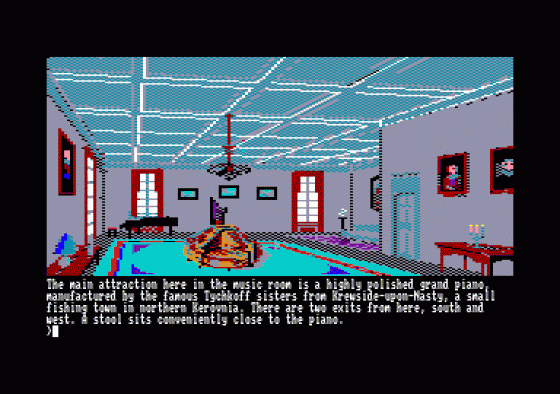
Amstrad Action
 1st February 1988
1st February 1988
Categories: Review: Software
Author: The Pilgrim
Publisher: Rainbird
Machine: Amstrad 6128
Published in Amstrad Action #29
Guild Of Thieves
Rainbird seem to be rather slow in bringing out Amstrad versions of adventures these days. Guild Of Thieves first saw the light of day back in June 1987 and it's taken another eight months to become available to CPC owners. Was it worth the wait?
Well, it all depends whether you fancy a game with an excellent parser, superb graphics, challenging puzzles, and inventive locations. You do? Then make no mistake, this is the game you should be splashing out on.
The Pawn made quite an impact on Amstrad adventuring. Although we've been treated to Level 9 titles without exception. Infocom have had a rather shakey presence on the Amstrad market. The Pawn was an all-British, impressive state-of-the-art game, from a company who never gave the impression of supporting the Amstrad machines anything less than 100%. Now we've got their second title, and their support becomes all the more valuable because of it.

First, Guild improves on The Pawn in every category. The plot is simpler (collect treasure) and less quirky, making it more appealing to those of us who found The Pawn a mite too weird for our tastes. The graphics are, believe it or not, even better. They've translated excellently from the 16-bit versions and some of the locations are positively mouthwatering.
In addition, the parser is improved (though with one or two quirks - see later) and although there are less human characters to encounter the puzzles themselves are, to my mind, more satisfying. There's a perfect blend between the simple, the subtle, and one or two perfect swines that take a lot of lateral thinking to solve.
Finally, the game runs on both a 6128 and a 464 with DkTronics memory expansion, so it's open to more of us than some of the more recent (and harder to find) Infocom titles.
Entry To The Guild

Membership of the Guild Of Thieves requires that successful applicants complete a gruelling test of their kleptological skills. Simple stuff, really -confronted by an item of value, you don't even have to know that the word "kleptology" doesn't exist to thrust it into your pack and transport it to the nearest night-safe, thereby increasing your score.
You start the game in a boat with a member of the Guild and from the moment you reach the shore you must go all out to ensure that not a single treasure remains unbanked. The landscape is terrific - a large country house to explore, a temple with a network of underground caves, a fairground, and a windmill, all concealing loot of every possible description.
Every time you bank a treasure, your score will go up. Regular saves are necessary as you dice with death, either at the hands of other characters or of Mother Nature. She's definitely red in tooth, claw, and coal in this game, so don't mess with the spider or dally on the glowing coals unless you know what you're doing. And there's also the possibility that when you bank an item, your score doesn't go up, which means you've probably just banked an object you're going to need badly later on to solve another puzzle. Oops.

Parsing is almost faultless. You can address other characters (though they aren't all that communicative) and perform miracles with containers. Relative positioning is also included, which means you can look under a bed, on a bed. or even behind a bed. This isn't implemented on most other games and I find it adds a lot to the feeling of "being there" while you're playing.
There's also a GO TO command, which allows you to GO TO a named location. You have to use this with care, however, because you can die if the route chosen by the program leads you via a fatal hazard (of which there are several in the game). I have just finished playing a 16-bit version of Magnetic Scrolls' latest game, Jinxter, in which the GO TO command has been withdrawn, possibly for this very reason. It is however extremely useful in certain circumstances - going from one room to another in the mansion, for example.
Great game, great graphics, what more can you want? Except possibly to receive an Amstrad copy of Jinxter a little quicker than the long wait we endured for Guild Of Thieves.











